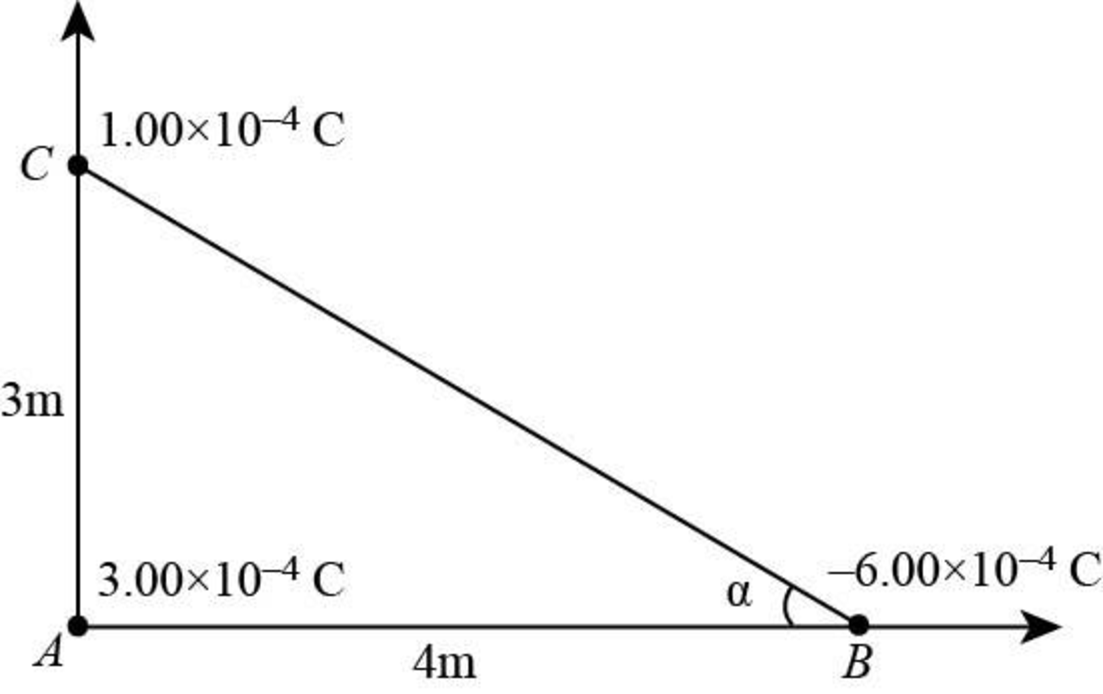
Concept explainers
Particle A of charge 3.00 × 10−4 C is at the origin, particle B of charge −6.00 × 10−4 C is at (4.00 m, 0), and particle C of charge 1.00 × 10−4 C is at (0, 3.00 m). We wish to find the net electric force on C. (a) What is the x component of the electric force exerted by A on C? (b) What is the y component of the force exerted by A on C? (c) Find the magnitude of the force exerted by B on C. (d) Calculate the x component of the force exerted by B on C. (e) Calculate the y component of the force exerted by B on C. (f) Sum the two x components from parts (a) and (d) to obtain the resultant x component of the electric force acting on C. (g) Similarly, find the y component of the resultant force vector acting on C. (h) Find the magnitude and direction of the resultant electric force acting on C.
(a)
The
Answer to Problem 23.18P
The
Explanation of Solution
The charge of particle
The diagram for the given condition is shown below.

Figure 1
Write the formula to calculate the electrical force
Here,
The particle
The distance from the
Thus, the
Conclusion:
Therefore, the
(b)
The
Answer to Problem 23.18P
The
Explanation of Solution
Write the formula to calculate the electrical force
Substitute
Conclusion:
Therefore, the
(c)
The magnitude of the force exerted by
Answer to Problem 23.18P
The magnitude of the force exerted by
Explanation of Solution
By Pythagoras theorem, write the expression distance between
Write the formula to calculate the electrical force
Here,
Substitute
Conclusion:
Therefore, the magnitude of the force exerted by
(d)
The
Answer to Problem 23.18P
The
Explanation of Solution
From part (c), the magnitude of the force exerted by
Resolve the side
From Figure I
Here,
Write the formula to calculate the
Here,
Substitute
Conclusion:
Therefore, the
(e)
The
Answer to Problem 23.18P
The
Explanation of Solution
From part (c), the magnitude of the force exerted by
Resolve the side
From Figure I,
Write the formula to calculate the
Here,
Substitute
Conclusion:
Therefore, the
(f)
The resultant
Answer to Problem 23.18P
The resultant
Explanation of Solution
From part (a), the
From part (d), the
Write the formula to calculate the resultant force acting on the particle
Here,
Substitute
Conclusion:
Therefore, the resultant
(g)
The resultant
Answer to Problem 23.18P
The resultant
Explanation of Solution
From part (b), the
From part (e), the
Write the formula to calculate the resultant force acting on the particle
Here,
Substitute
Conclusion:
Therefore, the resultant
(h)
The magnitude and direction of the resultant electric force acting on
Answer to Problem 23.18P
The magnitude and direction of the resultant electric force acting on
Explanation of Solution
From part (g), the resultant
From part (f), the resultant
Write the formula to calculate the resultant force acting on the particle
Here,
Substitute
Write the formula to calculate the direction of the resultant force acting on
Here,
Substitute
The direction of the resultant force is counterclockwise from
Conclusion:
Therefore, the magnitude and direction of the resultant electric force acting on
Want to see more full solutions like this?
Chapter 23 Solutions
EBK PHYSICS FOR SCIENTISTS AND ENGINEER
- A 7.80 g bullet is initially moving at 660 m/s just before it penetrates a block of wood to a depth of 6.20 cm. (a) What is the magnitude of the average frictional force (in N) that is exerted on the bullet while it is moving through the block of wood? Use work and energy considerations to obtain your answer. N (b) Assuming the frictional force is constant, how much time (in s) elapses between the moment the bullet enters the block of wood and the moment it stops moving? Sarrow_forwardPlease don't use Chatgpt will upvote and give handwritten solutionarrow_forwardTwo blocks, A and B (with mass 45 kg and 120 kg, respectively), are connected by a string, as shown in the figure below. The pulley is frictionless and of negligible mass. The coefficient of kinetic friction between block A and the incline is μk = 0.26. Determine the change in the kinetic energy of block A as it moves from to ①, a distance of 15 m up the incline (and block B drops downward a distance of 15 m) if the system starts from rest. ] 37° A © Barrow_forward
- A skateboarder with his board can be modeled as a particle of mass 80.0 kg, located at his center of mass. As shown in the figure below, the skateboarder starts from rest in a crouching position at one lip of a half-pipe (point). On his descent, the skateboarder moves without friction so that his center of mass moves through one quarter of a circle of radius 6.20 m. i (a) Find his speed at the bottom of the half-pipe (point Ⓡ). m/s (b) Immediately after passing point Ⓑ, he stands up and raises his arms, lifting his center of mass and essentially "pumping" energy into the system. Next, the skateboarder glides upward with his center of mass moving in a quarter circle of radius 5.71 m, reaching point D. As he passes through point ①, the speed of the skateboarder is 5.37 m/s. How much chemical potential energy in the body of the skateboarder was converted to mechanical energy when he stood up at point Ⓑ? ] (c) How high above point ① does he rise? marrow_forwardA 31.0-kg child on a 3.00-m-long swing is released from rest when the ropes of the swing make an angle of 29.0° with the vertical. (a) Neglecting friction, find the child's speed at the lowest position. m/s (b) If the actual speed of the child at the lowest position is 2.40 m/s, what is the mechanical energy lost due to friction? ]arrow_forwardA force acting on a particle moving in the xy plane is given by F = (2yî + x²), where F is in newtons and x and y are in meters. The particle moves from the origin to a final position having coordinates x = 5.60 m and y = 5.60 m, as shown in the figure below. y (m) B (x, y) x (m) (a) Calculate the work done by F on the particle as it moves along the purple path (0 Ⓐ©). ] (b) Calculate the work done by ♬ on the particle as it moves along the red path (0 BC). J (c) Is F conservative or nonconservative? ○ conservative nonconservativearrow_forward
- A 3.5-kg block is pushed 2.9 m up a vertical wall with constant speed by a constant force of magnitude F applied at an angle of 0 = 30° with the horizontal, as shown in the figure below. If the coefficient of kinetic friction between block and wall is 0.30, determine the following. (a) the work done by F J (b) the work done by the force of gravity ] (c) the work done by the normal force between block and wall J (d) By how much does the gravitational potential energy increase during the block's motion? ]arrow_forwardPhysics different from a sea breeze from a land breezearrow_forwardFile Preview Design a capacitor for a special purpose. After graduating from medical school you and a friend take a three hour cruise to celebrate and end up stranded on an island. While looking for food, a spider falls on your friend giving them a heart attack. Recalling your physics, you realize you can build a make-shift defibrillator by constructing a capacitor from materials on the boat and charging it using the boat's battery. You know that the capacitor must hold 100 J of energy and be at 1000 V (fortunately this is an electric boat which has batteries that are 1000 V) to work. You decide to construct the capacitor by tightly sandwiching a single layer of Saran wrap between sheets of aluminum foil. You read the Saran wrap box and fortunately they tell you that it has a thickness 0.01 mm and dielectric constant of 2.3. The Saran wrap and foil are 40 cm wide and very long. How long is the final capacitor you build that saves your friend?arrow_forward
- How do I plot the force F in Matlba (of gravity pulling on the masses) versus spring displacement, and fit the data with a linear function to find the value for the spring constant. To get a linear fit, use polynomial order 1. Report the value of 'k' from the fit. What code is used?arrow_forwardOk im confused on this portion of the questions being asked. the first snip is the solution you gave which is correct. BUt now it is asking for this and im confused. The magnitude of the force F_11 is __________LB. The direction of the force F_11 is __________LB.arrow_forwardNo chatgpt pls will upvotearrow_forward
 Physics for Scientists and Engineers: Foundations...PhysicsISBN:9781133939146Author:Katz, Debora M.Publisher:Cengage Learning
Physics for Scientists and Engineers: Foundations...PhysicsISBN:9781133939146Author:Katz, Debora M.Publisher:Cengage Learning Principles of Physics: A Calculus-Based TextPhysicsISBN:9781133104261Author:Raymond A. Serway, John W. JewettPublisher:Cengage Learning
Principles of Physics: A Calculus-Based TextPhysicsISBN:9781133104261Author:Raymond A. Serway, John W. JewettPublisher:Cengage Learning College PhysicsPhysicsISBN:9781305952300Author:Raymond A. Serway, Chris VuillePublisher:Cengage Learning
College PhysicsPhysicsISBN:9781305952300Author:Raymond A. Serway, Chris VuillePublisher:Cengage Learning College PhysicsPhysicsISBN:9781285737027Author:Raymond A. Serway, Chris VuillePublisher:Cengage Learning
College PhysicsPhysicsISBN:9781285737027Author:Raymond A. Serway, Chris VuillePublisher:Cengage Learning Physics for Scientists and EngineersPhysicsISBN:9781337553278Author:Raymond A. Serway, John W. JewettPublisher:Cengage Learning
Physics for Scientists and EngineersPhysicsISBN:9781337553278Author:Raymond A. Serway, John W. JewettPublisher:Cengage Learning Physics for Scientists and Engineers with Modern ...PhysicsISBN:9781337553292Author:Raymond A. Serway, John W. JewettPublisher:Cengage Learning
Physics for Scientists and Engineers with Modern ...PhysicsISBN:9781337553292Author:Raymond A. Serway, John W. JewettPublisher:Cengage Learning





